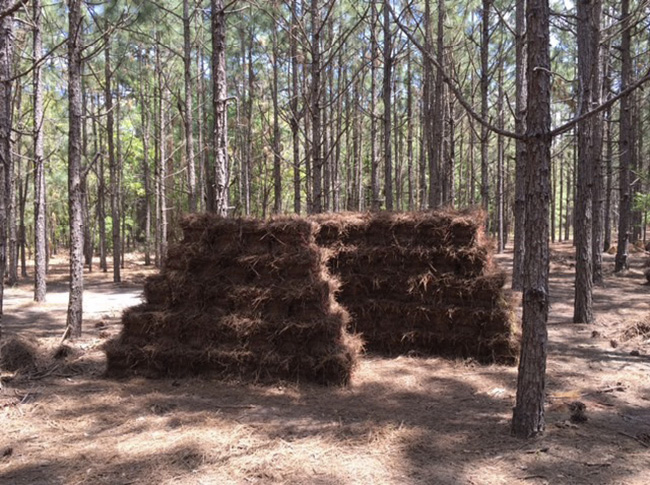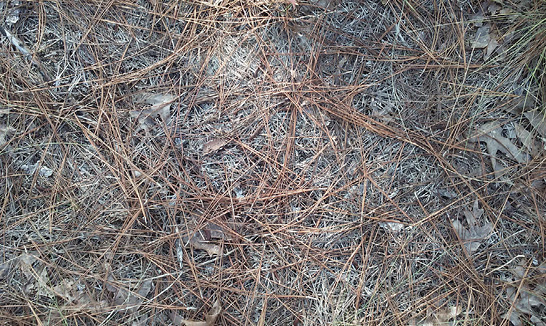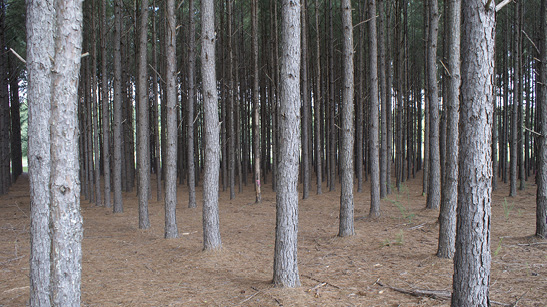Growing Pine Needles and Timber

One of the best things about owning forest land is the opportunity to manage for multiple objectives and products. For decades, financially motivated forest landowners could sell timber to strong local pulp and sawtimber markets. Recent declines in stumpage prices for both products have reduced profit margins, prompting many forest landowners to consider alternative management strategies.
Growing needles for the pine straw market is one way forest landowners can generate additional income. Pine straw has become a popular mulching material because of its insulating qualities and aesthetics. Pine straw (recently fallen, undecomposed pine needles) has many advantages over other mulches. For example, it does not float or wash away like bark chips while being easier to apply and costing less than stone. In addition, unlike synthetic materials, it adds nutrients and promotes soil tilth in landscaping which stimulates healthy root development of plants. Pine straw can also be used to limit erosion around construction sites or recently burned areas.
While selling pine needles may seem trivial, the value of pine straw has increased tremendously in the last decade (Boatwright & McKissick, 2000–2010). Indeed, pine straw has become a significant forest commodity in several Southeastern states. Although the pine straw market in Mississippi is not as developed as in some states, interest in both raking and selling pine straw has increased over the past decade. Consequently, forest landowners may want to consider pine straw in future management plans.
This publication gives landowners information on how to generate additional income from their timberland while growing sawtimber. It addresses common questions regarding species and site considerations, planting strategies, vegetation management options, nutrient management options, and best management practices for producing pine straw.
Species Considerations
Historically, longleaf (Pinus palustris) and slash pine (P. elliottii) have been the preferred species for pine straw production. Landscapers prefer these species because the longer needles bale better, the reddish-brown color fades more slowly, and the rate of deterioration is slower than loblolly (P. taeda) needles (Figure 1). Thus, pine straw raking tends to be more profitable in southern Mississippi, where longleaf and slash pine grow naturally. Nevertheless, there is a potential market in the northern half of the state where loblolly pine is dominant and needles may be produced and transported at lower costs than alternative mulches. Some experts have noted loblolly to be a better mulch for vegetable crops (Morris et al., 1992). Loblolly straw can also be used for limiting erosion around construction sites. Although forest landowners in northern Mississippi are not able to grow preferred species for straw production, Loblolly straw offers economic opportunities.


Figure 1. Comparison between needles of longleaf pine (top) and loblolly pine (bottom). Photos by John L. Willis, U.S. Forest Service.
Site Considerations
Every pine stand generates straw, but not every stand is feasible to rake. First, the stand should be flat (< 8% slope). Land with above-average erosion or land that is subject to surface compaction should not be considered because pine straw serves to protect the soil. Flat ground also facilitates equipment access. Pine straw harvesting is best performed on productive, clay soils. By contrast, deep, sandy soils need the nutrients bound in fallen pine needles. If pine straw is removed, productivity will decrease. This is particularly important if growing timber is a management objective. Slower growing trees create longer, less profitable sawtimber rotations. Removing straw from sandy sites can also increase pine moisture stress, which can increase the risk of attack from southern pine beetles (Dendroctonus frontalis), deodar weevils (Pissodes nemorensis), or Ips bark beetles (Ips spp.).
Existing understory vegetation is another important factor to consider. The site should be free of established understory vines. Many contractors will not bid on stands where these vines are present in quantity, as baling becomes very inefficient. Stands should also be free of invasive species before raking operations commence. Species that develop rhizomes such as cogongrass (Imperata cylindrica) (Figure 2) and Japanese climbing fern (Lygodium japonicum) (Figure 3) can be unintentionally baled with pine needles, facilitating their spread. While there are no laws currently regulating invasive species in the pine straw industry, forest landowners should practice good stewardship and forgo raking opportunities until the invasive species have been eradicated from the understory. Further information on commonly encountered invasive species and recommendations for controlling them can be found in MSU Extension Publication 2873 Herbicide Options for Hardwood Management (Self & Ezell, 2020).

Figure 2. Cogongrass invading a pine stand. Photo by Brady Self.
.jpg)
Figure 3. Japanese climbing fern growing within a pine stand. Photo by John L. Willis, U.S. Forest Service.
Straw Management
For financially motivated landowners, one of the more attractive aspects of growing straw is how easily it can be incorporated into timber management plans. Pine plantations managed for timber production are efficient at producing pine straw. Needle production is maximized, and needles are evenly spread within the stand. In addition, even between-row spacing helps synchronize canopy closure (the developmental stage when tree branches in adjacent rows completely overlap) (Figure 4), which helps control understory vegetation growth.

Figure 4. View of a pine plantation reaching the canopy closure stage of development. Photo by John L. Willis, U.S. Forest Service.
Many landowners have questions regarding planting density. While planting at a higher density (700 or more trees per acre) may seem beneficial for straw production, there is a biological limit to needle production. Higher density planting will result in stands reaching canopy closure faster than stands planted at lower densities (e.g., 450–600 TPA), but individual trees will have smaller crowns and fewer needles. Moreover, higher density plantings generally result in higher mortality and slower diameter growth. This typically results in patchy straw production, longer timber rotations, and the possible need for pre-commercial thinning. Consequently, planting at a high density is not recommended.
Another aspect of planting that landowners should pay attention to is spacing. Distance between pine tree rows has little impact on hand baling operations; however, newer mechanical balers require at least 8 feet to safely navigate between trees. Further information on seedling spacing can be found in Table 1. Failure to properly space rows could result in fewer contractors bidding on your property.
Source: MSU Extension Publication 1776 Planting Southern Pines: A Guide to Species Selection and Planting Techniques.
|
Spacing (feet) |
Number of seedlings |
|
6 x 8 |
907 |
|
6 x 9 |
806 |
|
6 x 10 |
726 |
|
6 x 11 |
660 |
|
6 x 12 |
605 |
|
7 x 7 |
888 |
|
7 x 8 |
777 |
|
7 x 9 |
691 |
|
7 x 10 |
622 |
|
7 x 11 |
565 |
|
7 x 12 |
518 |
|
8 x 8 |
680 |
|
8 x 9 |
605 |
|
8 x 10 |
544 |
|
8 x 11 |
495 |
|
8 x 12 |
453 |
|
9 x 9 |
537 |
|
9 x 10 |
484 |
|
9 x 11 |
436 |
|
9 x 12 |
403 |
|
10 x 10 |
435 |
|
10 x 11 |
396 |
|
10 x 12 |
363 |
|
12 x 11 |
330 |
|
12 x 12 |
302 |
|
12 x 15 |
242 |
|
15 x 7 |
414 |
|
15 x 8 |
363 |
|
15 x 9 |
322 |
|
15 x 10 |
290 |
|
15 x 15 |
193 |
Table 1. Row spacing options and resulting seedling densities.
After planting, a stand generally requires between 9 and 15 years to reach canopy closure. It is at this point that needle production is maximized. Raking can be conducted prior to canopy closure; however, it is important not to rake before the stand reaches age 8. The small amount of straw that can be harvested before this age is unlikely to justify the logistical challenges and negative growth impact of early raking.
Prior to any raking operation, it is critical that the understory be clean (absent of volunteer trees, shrubs, herbaceous vegetation, sticks, or cones) (Figure 5). Some contractors consider this service as part of their initial bid; however, the cost of this work will be reflected in the price offered for straw. For landowners interested in actively managing their property, the best way to achieve a clean understory is with a combination of herbicide and prescribed fire treatments. Herbicides are generally considered the most effective tool for controlling unwanted vegetation.
Pine-safe herbicides can be applied using several methods: hack-n-squirt, backpack sprayer, or through mechanical means. The type of application prescribed is determined based on size and density of vegetation to be removed. Table 2 lists common treatments and associated chemical applications. Remember to read product labels or consult a professional for more specific information, safety concerns, and application procedures. Once herbicides have controlled understory vegetation, a dormant-season prescribed burn can be conducted to reduce residual woody debris. From this point forward, prescribed fire will be the primary tool for maintaining open understory conditions. Prescribed burns should be conducted between rakes on a 2- to 3-year burning interval.

Figure 5. A pine understory in clean condition for raking. Photo by Brady Self.
Table 2. Herbicide application techniques for controlling understory vegetation.
|
Treatment |
Vegetation characteristics |
Typical herbicides1 |
Application |
|
Backpack spray |
< 6 ft high |
Combination of glyphosphate and imazapyr with surfactant |
Spray foliage to 2/3 of crown during late summer through fall. Do not spray glyphosphate on pine foliage. |
|
Broadcast or banded Spray |
Imazapyr, glyphosphate, or sulfometuron for herbaceous species |
Use ATV or small tractor with applicator tank and nozzles attached to spray foliage during late summer through fall. For grasses, apply glyphosphate in the spring, but keep away from pine foliage. |
|
|
Basal spray (direct) |
> 6 ft high, stem diameters < 6 in, thin bark species |
Triclopyr (ester) with surfactant |
Spray root collar (the base of the trunk where stem meets soil) late summer through winter. |
|
Hack-n-squirt (direct) |
Diameter > 6 in |
Imazapyr |
Using a hatchet, create an opening just inside outer bark. Use squirt bottle to place herbicide in the opening (one pull of the trigger). Application should be performed fall through winter. |
|
Spot (direct) |
Multiple stems in small area |
Hexazinone or sulfometuron for herbaceous species |
Use squirt bottle or backpack to treat soil at base of stems. |
Thinning
Canopy closure marks the point of maximum needle production in a stand. This is also when competition for resources begins to intensify. For this reason, needle production begins to decline and stress within a stand begins to increase. Eventually, it will become necessary to thin the stand to reduce stress. Thinning should occur before a stand reaches 110–120 square feet of basal area per acre. (Basal area is a measure of stand density used to assess the cross-sectional amount of wood on an acre in feet squared. Higher basal area values indicate more wood on an acre.) Thinning increases resources to residual trees, but it also reduces the amount of needles available to rake. Furthermore, thinning increases light to the forest floor, which stimulates understory vegetation growth. For these reasons, some landowners choose to exit the pine straw raking business after the first thinning; however, this does not mean the only choices are spending more money or forgoing straw raking entirely. Leaving a higher residual basal area (80 or more square feet) will help maintain more needles and provide a degree of understory vegetation control. This strategy could be combined with growing timber for the utility pole market and may be particularly beneficial for landowners growing longleaf pine.
Fertilization
The forest floor contains a large portion of the total nutrient loading present within a stand. Trees depend on these mineral nutrients for growth and survival, and one of the major concerns with pine straw raking is their loss. Indeed, repeated rakings have been shown to negatively influence nutrient availability (Chevasco et al., 2016). One way to combat this is to add nutrients back through fertilization. Fertilizers are typically applied in late January or early February about 4 years before the first thinning and 4 years before the final harvest. High-quality sites are fertilized after stands have been raked intensively for 3 to 5 years. Lower-quality sites will require more frequent fertilization to retain productivity. Morris et al. (1992) recommend the application of 200 pounds of diammonium phosphate (18-46-0) per acre. Alternatively, straw growers can add 100 pounds of nitrogen (ammonium nitrate or urea), 50 pounds of phosphorous (triple super phosphate and ground rock phosphate), and 50 pounds of potassium (potassium sulfate) per acre. Remember that application rates vary. For instance, sandy soils have a low cation exchange capacity and do not hold nutrients well. Morris et al. (1992) and Dickens et al. (2004) make further recommendations based on site and stand characteristics and application regime. Fertilizers should not be applied to stands when risk of annosus root rot (Heterobasidion annosum) is moderate to high or where pitch canker (Fusarium circinatum) is found in the stand (Dickens et al., 2004). It is highly recommended that soil and foliar nutrient tests are performed before adding any fertilizers, as overfertilizing the site can cause significant damage and mortality if nutrient loads become too high. Thus, landowners are strongly encouraged to consult a registered forester, natural resource professional, or MSU Extension agent before adding fertilizers. For further information on performing a soil test, consult MSU Extension Information Sheet 1294 Soil Testing for the Homeowner (Jones, 2020).
Altering frequency and intensity of straw harvesting also can help mitigate loss of essential plant nutrients. Harvesting on 3-year intervals will allow for a modest recovery of nutrients within the stand. Nutrient losses can also be reduced by raking early in the fall. Operations occuring in September are ideal for nutrient conservation, as needle fall in October and November would remain on the forest floor; however, a smaller straw harvest will result. Periodic applications of prescribed burning can also increase nutrient availability. In particular, prescribed fire increases availability of base cations, like potassium, and stimulates inorganic nitrogen production. Moreover, as previously mentioned, fire will help keep the understory clean. Thus, prescribed burning is an excellent management tool for landowners interested in producing straw.
Raking Frequency
There are several different raking regimes. At one end of the spectrum, stands could be raked every year. Depending on several factors, this approach could allow for as many as 8–10 rakes before the first thinning; however, landowners should remember that raking this intensively will slow pine growth unless fertilization is employed. On the other end of the spectrum, landowners could rake on 4- or 5-year rotations. This approach would reduce straw proceeds but would also have the lowest impact on pine growth. The most common approach is to rake on 2- or 3-year intervals which provides a balance of straw proceeds and negative effects on pine growth.
Best Management Practices (BMPs)
BMPs are highly recommended managing forests. While Mississippi landowners are not required to follow BMPs, these recommendations are designed to protect water quality and animal life. If every Mississippi forest landowner voluntarily complies with these recommendations, mandatory BMPs, as found in other states, can be averted. Finally, it is important to voluntarily implement BMPs because pollution or degradation of waterways is in violation of state law (Statutes 49-17-29 and 97-15-41, Miss. Code, 1972). Streamside management zones (SMZs) are vegetated areas adjacent to streams and watercourses that help protect them from polluting chemicals and sedimentation. The minimum SMZ width on a perennial or intermittent stream is at least 30 feet on both sides of a waterway. For perennial streams, SMZ width increases as slope of the land adjacent to the stream increases.
The majority of environmental problems associated with prescribed fire are related to erosion stemming from plowed firelines. The Mississippi BMP guidelines state that firelines should not be constructed within an SMZ. Further, if a fireline is to be anchored to an SMZ, the line should be turned at the edge of the SMZ, so that the plowed line runs parallel. Finally, prescribed fire temperatures should be kept cool near SMZs to avoid alterations in soil chemistry that reduce soil infiltration, which can increase surface runoff.
Care should also be taken when applying herbicides near streams. If a herbicide is applied within an SMZ, the application should be by injection or direct spray application and then, only if label instructions approve the product for SMZ application. Under no circumstances should chemicals be applied to moving surface waters unless the product is expressly labeled for aquatic use. Do not rinse equipment or discharge rinse water into water bodies, and remember to remove all herbicide containers from the site.
Summary
Declines in pulp and sawtimber markets have stimulated interest in alternative markets for pine products. Compared to other southern states, Mississippi has a relatively small pine straw industry; however, interest in pine straw has been steadily increasing. For many landowners, the primary advantage of growing pine straw is how easy it is to incorporate into traditional timber management plans. While this certainly is an advantage, landowners should recognize that growing straw requires a greater investment in understory vegetation control and fertilization than most forms of timber management. Moreover, landowners should be aware that loblolly pine is less desirable for straw contractors than some other pine species; therefore, returns received on a loblolly plantation may be less than a neighboring property growing longleaf or slash pine. Consequently, we urge landowners to consider these factors before pursuing pine straw harvesting. We also encourage landowners to contact Mississippi State University Extension Forestry (extension.msstate.edu/natural-resources/forestry) for further advice on growing pine straw or finding a local contractor.
References
Boatwright, S.R. and J.C. McKissick. 2000-2010. Georgia Farm Gate Value Reports. AR-00-01 through AR-10-01. Center for Agribusiness and Economic Development, College of Agricultural and Environmental Sciences, UGA, Athens, GA. pp. 175.
Chevasco, E.D., P.J. Minogue, C. Mackowiak, and N.B. Comerford. 2016. Fertilization and pine straw raking in slash pine plantations: P removals and effects on total and mobile soil, foliage, and litter P pools. Forest Ecology and Management, 376, pp. 310-320.
Jones, K. 2020. Soil testing for the homeowner. Mississippi State University Extension, Information Sheet 1294.
Dickens, E.J., D.J. Moorhead, L.A. Morris, and B.C. McElvany. 2004. Straw raking in southern pine stands and fertilization recommendations.
Morris, L.A., E.J. Jokela, and J.B. O-Connor, Jr. 1992. Silvicultural guidelines for pine straw management in the southeastern United States. Georgia Forest Res. Paper #88. 11 p. Georgia Forestry Commission, Macon, GA.
Self, A.B., and A.W. Ezell. 2020. Herbicide options for hardwood management. Mississippi State University Extension, Publication 2873.
Publication 3129
Revised by Brady Self, PhD, Associate Extension Professor, Forestry; from an earlier version by John Willis, PhD, Former Assistant Professor, Forestry; and Jason Gordon, PhD, Associate Extension Professor, Forestry.
Copyright 2020 by Mississippi State University. All rights reserved. This publication may be copied and distributed without alteration for nonprofit educational purposes provided that credit is given to the Mississippi State University Extension Service.
Produced by Agricultural Communications.
Mississippi State University is an equal opportunity institution. Discrimination in university employment, programs, or activities based on race, color, ethnicity, sex, pregnancy, religion, national origin, disability, age, sexual orientation, genetic information, status as a U.S. veteran, or any other status protected by applicable law is prohibited. Questions about equal opportunity programs or compliance should be directed to the Office of Compliance and Integrity, 56 Morgan Avenue, P.O. 6044, Mississippi State, MS 39762, (662) 325-5839.
Extension Service of Mississippi State University, cooperating with U.S. Department of Agriculture. Published in furtherance of Acts of Congress, May 8 and June 30, 1914. GARY B. JACKSON, Director
The Mississippi State University Extension Service is working to ensure all web content is accessible to all users. If you need assistance accessing any of our content, please email the webteam or call 662-325-2262.







